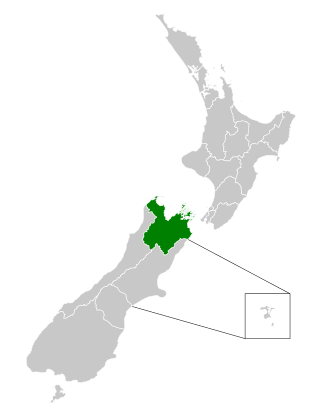
South Auckland is one of the major geographical regions of Auckland, the largest city in New Zealand. The area is south of the Auckland isthmus, and on the eastern shores of the Manukau Harbour. The area has been populated by Tāmaki Māori since at least the 14th century, and has important archaeological sites, such as the Ōtuataua stonefield gardens at Ihumātao, and Māngere Mountain, a former pā site important to Waiohua tribes.

Middlemore Hospital is a major public hospital in the suburb of Ōtāhuhu, Auckland, New Zealand. The hospital has approximately 800 beds. There are 24 operating theatres across two sites.
Southern Cross group, a collection of independent, health-oriented businesses in New Zealand, operates on not-for-profit principles and is New Zealand's largest non-public health care organisation. The Group's businesses include health insurance, private hospitals and healthcare, travel insurance and pet insurance. The Group encompasses the Southern Cross Medical Care Society and the Southern Cross Health Trust and their respective subsidiaries.

The Whanganui District Health Board was a district health board that provided healthcare to the Wanganui, Rangitikei, and parts of the Ruapehu districts of New Zealand. In July 2022, it was merged into the national health service Te Whatu Ora.

Auckland District Health Board (ADHB) was a district health board that provided healthcare in the Auckland Region in New Zealand, mainly on the Auckland isthmus. This district health board existed between 2001 and 2022 and was governed by a part-elected, part-appointed board. In 2022, its functions and responsibilities were subsumed by Te Whatu Ora and Te Aka Whai Ora.

The South Canterbury District Health Board was a district health board with the focus on providing healthcare to the Timaru, Mackenzie, Waimate districts in New Zealand. In July 2022, it was merged into the national health service Te Whatu Ora.

The Canterbury District Health Board was a district health board with the focus on providing healthcare to the Canterbury region of New Zealand, north of the Rangitata River. It was responsible for roughly 579,000 residents, or 12% of New Zealand's population. The Canterbury District Health Board covered a territory of 26,881 square kilometers and was divided between six territorial local authorities. In July 2022, the Canterbury DHB was merged into the national health service Te Whatu Ora.

The Capital and Coast District Health Board (CCDHB) was a district health board with the focus on providing healthcare to Wellington City, Porirua City and the Kāpiti Coast in New Zealand. The CCDHB employed about 6000 people across the Wellington Region. It was disestablished on 1 July 2022, with its functions and responsibilities being taken over by the national health service Te Whatu Ora.

MidCentral District Health Board was a district health board that provided healthcare in the Manawatū region of New Zealand. The DHB covers the Manawatū District, Palmerston North City, Tararua District, Horowhenua District, and the Ōtaki ward of the Kāpiti Coast District. In July 2022, the MidCentral DHB was merged into the national health service Te Whatu Ora.

The Bay of Plenty District Health Board was a district health board with the focus on providing healthcare to the Bay of Plenty area of New Zealand. In 2022, the Bay of Plenty DHB was dissolved as part of a national overhaul of the district health board system. Its former functions and responsibilities were assumed by Te Whatu Ora.

The Hawke's Bay District Health Board was a district health board with the focus on providing healthcare to Hawke's Bay, New Zealand. In July 2022, it was merged into the national health service Te Whatu Ora.

The Hutt Valley District Health Board was a district health board that provided healthcare to the cities of Lower Hutt and Upper Hutt in New Zealand. In July 2022, the Hutt Valley DHB was merged into the national health service Te Whatu Ora.

The Lakes District Health Board was a district health board that provided healthcare to the area covered by Taupō and Rotorua districts in New Zealand. In July 2022, the Lakes DHB was merged into the national health service Te Whatu Ora.

The Nelson Marlborough District Health Board was a district health board with the focus on providing healthcare to the Nelson, Tasman and Marlborough districts of New Zealand. In July 2022, it was merged into the national health service Te Whatu Ora.

The Northland District Health Board is a district health board with the focus on providing healthcare to the Northland Region of New Zealand. In July 2022, the Northland DHB was merged into the national health service Te Whatu Ora.

The Southern District Health Board was a district health board which provided healthcare to an area covering the southern half of the South Island of New Zealand. In July 2022, the Southern DHB was dissolved as part of a nationwide overhaul of the district health board system. Its former functions and responsibilities were taken over by Te Whatu Ora.

The Taranaki District Health Board was a district health board which provided healthcare to the Taranaki region of New Zealand. In July 2022, the Taranaki DHB was merged into the national health service Te Whatu Ora.

The Waikato District Health Board was a district health board that provided healthcare to the Waikato region of New Zealand.

The Waitemata District Health Board was a district health board that provided healthcare to people living in the area that used to be covered by North Shore city, Rodney District, and Waitakere City in New Zealand. It was abolished on 1 July 2022, and replaced with Te Whatu Ora.


















